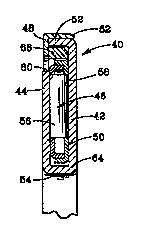Some of the information on this Web page has been provided by external sources. The Government of Canada is not responsible for the accuracy, reliability or currency of the information supplied by external sources. Users wishing to rely upon this information should consult directly with the source of the information. Content provided by external sources is not subject to official languages, privacy and accessibility requirements.
Any discrepancies in the text and image of the Claims and Abstract are due to differing posting times. Text of the Claims and Abstract are posted:
| (12) Patent Application: | (11) CA 2181442 |
|---|---|
| (54) English Title: | THRUST BEARING ASSEMBLY |
| (54) French Title: | ENSEMBLE A PALIER DE BUTEE |
| Status: | Deemed Abandoned and Beyond the Period of Reinstatement - Pending Response to Notice of Disregarded Communication |
| (51) International Patent Classification (IPC): |
|
|---|---|
| (72) Inventors : |
|
| (73) Owners : |
|
| (71) Applicants : | |
| (74) Agent: | SWABEY OGILVY RENAULT |
| (74) Associate agent: | |
| (45) Issued: | |
| (86) PCT Filing Date: | 1994-07-11 |
| (87) Open to Public Inspection: | 1995-10-12 |
| Availability of licence: | N/A |
| Dedicated to the Public: | N/A |
| (25) Language of filing: | English |
| Patent Cooperation Treaty (PCT): | Yes |
|---|---|
| (86) PCT Filing Number: | PCT/US1994/007700 |
| (87) International Publication Number: | WO 1995027149 |
| (85) National Entry: | 1996-07-17 |
| (30) Application Priority Data: | ||||||
|---|---|---|---|---|---|---|
|
A thrust washer (42) has a radially directed annular portion providing a first raceway (58) and an axially directed annular flange
(52). A subassembly (46) comprising a pluraiity of rollers (56), in rolling contact with the raceway, retained axially and radially in roller
cage (50), has a pilot surface facing the axially directed annular flange. Friction reducing means (66, 82) between the pilot surface and the
axially directed annular flange reduces friction between the pilot surface and the flange while maintaining concentricity of the subassembly
(46) relative to the thrust washer (42).
Rondelle de butée (42) possédant une partie annulaire à extension radiale constituant un premier chemin de roulement (58), ainsi qu'un rebord annulaire à extension axiale (52). Un sous-ensemble (46) comportant plusieurs rouleaux (56) aptes à rouler au contact du chemin de roulement, et retenus dans les sens axial et radial dans une cage à rouleaux (50), possède une surface de guidage en regard du rebord annulaire à extension axiale. Un organe (66, 82) est monté entre la surface de guidage et le rebord annulaire à extension axiale et sert à réduire le frottement entre ceux-ci tout en conservant la concentricité du sous-ensemble (46) par rapport à la rondelle de butée (42).
Note: Claims are shown in the official language in which they were submitted.
Note: Descriptions are shown in the official language in which they were submitted.

2024-08-01:As part of the Next Generation Patents (NGP) transition, the Canadian Patents Database (CPD) now contains a more detailed Event History, which replicates the Event Log of our new back-office solution.
Please note that "Inactive:" events refers to events no longer in use in our new back-office solution.
For a clearer understanding of the status of the application/patent presented on this page, the site Disclaimer , as well as the definitions for Patent , Event History , Maintenance Fee and Payment History should be consulted.
| Description | Date |
|---|---|
| Time Limit for Reversal Expired | 1999-07-12 |
| Application Not Reinstated by Deadline | 1999-07-12 |
| Deemed Abandoned - Failure to Respond to Maintenance Fee Notice | 1998-07-13 |
| Application Published (Open to Public Inspection) | 1995-10-12 |
| Abandonment Date | Reason | Reinstatement Date |
|---|---|---|
| 1998-07-13 |
The last payment was received on
Note : If the full payment has not been received on or before the date indicated, a further fee may be required which may be one of the following
Please refer to the CIPO Patent Fees web page to see all current fee amounts.
| Fee Type | Anniversary Year | Due Date | Paid Date |
|---|---|---|---|
| MF (application, 3rd anniv.) - standard | 03 | 1997-07-11 | 1997-06-19 |
| MF (application, 2nd anniv.) - standard | 02 | 1996-07-11 |
Note: Records showing the ownership history in alphabetical order.
| Current Owners on Record |
|---|
| THE TORRINGTON COMPANY |
| Past Owners on Record |
|---|
| THOMAS G. RHOADS |